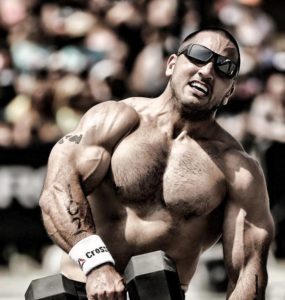Amber Larsen
I have been hearing a lot about how there is steroid use in CrossFit. I will not say I can tell if someone is using steroids, nor will I talk ill about the blogs I have read, but all I can truthfully say is that I do not know if someone is using steroids unless I have tested their urine sample. I do not believe that every person in CrossFit or the CrossFit Games is using steroids. The reason for this I hope can be explained in this article about natural hormone increases brought on by heavy resistance training.

A Bit About Performance Enhancing Drugs
First, an exploration of performance enhancing drugs (PEDs). There are usually two classifications of PEDs, hormones and dietary supplements. We will specifically go into the hormonal part because this is what people mostly think of in regards to PED use and CrossFit.
In most cases, people writing about CrossFitters using “steroids” are speaking aboutanabolic steroids. Anabolic steroids are synthetic derivatives of the male sex hormone testosterone. Physiologically elevated levels of testosterone stimulate protein synthesis resulting in improvements in muscle size, body mass, and strength. These potential changes in mass and strength have made anabolic steroids the drug of choice for strength and power athletes or those interested in gaining muscle size.
Testosterone itself is a poor ergogenic aid. Rapid degradation occurs when testosterone is given, therefore chemical modification of testosterone was necessary to retard the degradation process in order to achieve androgenic and anabolic effects at lower concentrations and to provide effective blood concentrations for longer periods of time. Just to be clear there are other forms of PEDs in the hormone class including insulin, human growth hormone (HGH), pro-hormones, erythropoietin (EPO), β-adrenergic agonists, and β-blockers. Chances are when someone talks about an athlete being “on steroids” it actually could be any one of a number of PEDs that are (or are not) being used.
Steroids or Strength Training?
Long-term weight training brings significant adaptations that can result in enhanced size, strength, and power of trained musculature. When there is anincrease in anabolic hormones brought about by heavy weight lifting, it can increase hormonal interactions with various cellular mechanisms and enhance the development of muscle protein contractile units. When there is stimulation from a motor neuron to initiate muscle contraction, various signals are sent from the brain and muscles to endocrine glands.

Hormones are secreted during and after weight lifting due to the physiological stress of the exercise itself. Hormone secretion provides information to the body regarding the amount and type of physiological stress (e.g. epinephrine), the metabolic demands (e.g. insulin), and the need for changes in resting metabolism. Thus, specific patterns of nervous system stimulation from weight training results in certain hormonal changes that are simultaneously activated for specific purposes related to recovery and adaptation to the acute exercise stress.
The patterns of stress and hormonal responses combine to shape the tissues’ adaptive response to a specific training program (like Olympic and powerlifting). So without going into anything too confusing, the specific force produced by the activated muscle fibers determines the alteration in hormone receptor sensitivity to anabolic hormones as well as changes in receptor synthesis. As few as one or two weight lifting days can increase the number of androgen receptors (the receptors for testosterone) in the muscle tissue. Combined, these alterations lead to muscle growth and strength increase in the intact muscle.
Following strength training sessions, remodeling of the muscle tissue takes place in the environment of hormonal secretions that provide for anabolic actions. There is an increase in the synthesis of actin and myosin and a reduction in protein degradation. Now, here is the catch to all of this great stuff due to strength training. If the stress is too great for the athlete, catabolic actions in the muscle may exceed anabolic as a result of the inability of anabolic hormones to bind to their receptors or the down regulation of receptors in the muscle tissue. So hormonal actions are important both during and after an exercise session to respond to the demands of the exercise stress. The magnitude of hormonal response depends on the amount of tissue stimulated, the amount of tissue remodeling, and the amount of tissue repaired after strength training sessions.

Only muscles fibers activated by the strength training are able to be adapted. Here is where genetics and muscle fiber types come into play (I know some of you were waiting for it). Some fibers may be close to the athlete’s genetic ceiling for cell size, while others may have a great potential for growth. This is where many people draw their conclusion as to the fact that CrossFitters are on performance-enhancing drugs, because many believe that people only have a certain ceiling for cell growth, but ultimately, unless we can see your genetic code, no one can know for certain what your genetic ceiling is for skeletal muscle cell size.Just because someone doesn’t look like you, doesn’t mean it’s impossible to look like that.
Now going back to hormones, the extent of hormonal interactions in the growth of muscle fibers is directly related to the adapted size of the fibers. Thus, if an exercise program uses the same exercises over and over again, only a specific set of muscle fibers associated with those movements will be activated and stimulated to grow. Since CrossFit is the epitome of variety, in most cases people are working various muscle groups at any given time, which will aid in the growth of all muscle groups, not just one individual group. Studies show that the volume of work, rest periods between sets, and the type of exercise are vital to the response pattern and magnitude of hormonal changes in men and women.

PEDS, Steroids, and Stereotypes
Now many of you may be wondering what all of this has to do with steroids and other PEDs. This has everything to do with why people may fit a stereotype, but not actually be on PEDs – and all because of how they exercise. Every athlete is on a different schedule and type of programming. How an athlete chooses to exercise has an impact how the body responds to hormone interaction. Our bodies all produce their own hormones, and some people have tapped into something within their own bodies that makes them productive in regards to their own hormone secretion.
So just because some people look as though they have only 3% body fat does not automatically mean they are loaded on PEDs. It could mean they have found something that works for them and makes them extremely efficient at using the hormones produced in their own bodies. And there is even more going on to getting strong than what I mentioned here in this article. We didn’t take into account diet, supplementation, or health history. There is a lot going on biologically when it comes to cell growth than what we can see from the outside.
PEDs and CrossFit Competition
As CrossFit becomes more popular in the sports arena, it will be important to ensure that athletes are competing without the help of PEDs. CrossFit does require urine tests for Games-level competitors, but it does so without the help of a third party that has no involvement with the CrossFit organization itself. As the popularity of the sports and the purse sizes grow, this may become a problematic scenario in regards to the drug status of the competitors.
As for right now, there is no need for CrossFitters to get so bent out of shape that people critiquing potential drug use have to pull down their blogs. Everyone has an opinion, even if it may not be valid to you or anyone else you may know. The best thing for us as CrossFitters to do is to be honest, continue to do what we are doing, and not sweat the small stuff. It all comes out in the wash in the end.
References:
1. Tate, Phillip. Seeley’s Principles of Anatomy and Physiology. (New York: McGraw Hill Companies), 220.
2. Baechle, Thomas R and Roger, Earle W. Essentials of Strength Training and Conditioning. (Illinois: Human Kinetics), 49-50.
A true love for sports


Recent Comments